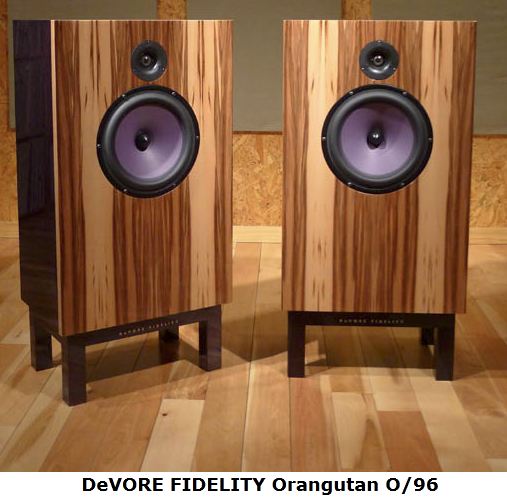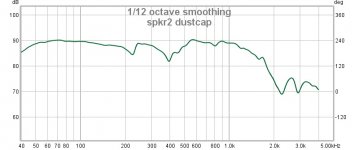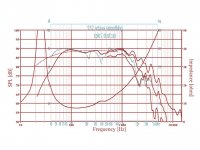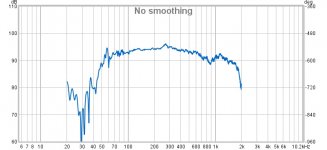Can anybody tell me if the attachment woofer sweep looks normal in any way?
Sweep is miniDSP umik-2 with REW. Speaker is mic'd near-field about 1/8 in off the dust cap. Other distances still show the anomalies, even more exaggerated. Test cab is a closed box 88 liters no stuffing.
I've discussed this with the seller, but they thought it was within normal parameters and told me to break them in! I close-mic'd one of my Vandersteens' woofer and it looked great.
BTW, both speakers look essentially the same, so a random defect seems unlikely.
Any suggestions appreciated.
Brad
Sweep is miniDSP umik-2 with REW. Speaker is mic'd near-field about 1/8 in off the dust cap. Other distances still show the anomalies, even more exaggerated. Test cab is a closed box 88 liters no stuffing.
I've discussed this with the seller, but they thought it was within normal parameters and told me to break them in! I close-mic'd one of my Vandersteens' woofer and it looked great.
BTW, both speakers look essentially the same, so a random defect seems unlikely.
Any suggestions appreciated.
Brad
Attachments
Last edited:
Not an expert but did a quick overlay of the published spec from Seas and your graph and it all looks pretty good except the two dips at just over 200hz and 400hz. You obviously get some bass extension and it seems as though the top end rolls off a bit earlier (doe this have a crossover in place ?).
200hz and 400hz equate to a wavelength of around 1.75m and 0.875m are there any edges/walls/equipment stands etc. this close to where you are measuring that may cause reflections even for a close mic situation.
Just some uneducated thoughts.
200hz and 400hz equate to a wavelength of around 1.75m and 0.875m are there any edges/walls/equipment stands etc. this close to where you are measuring that may cause reflections even for a close mic situation.
Just some uneducated thoughts.
Attachments
Anything below 300-400 hz is usually some kind of reflective issue, plus its a very close mic placement measurement which can introduce phase anomalies being that close to an individual radiating area on the cone. More than likely you're seeing a boundary reflection somewhere. Pics of the measurement setup?
I think the 400Hz dip is the spider resonance. You can see it in the impedance curve. Most drivers have that in the 400 - 500hz range. The dip seems deeper than usual though. The early roll off at the top end is due to the close microphone position.
Also, that driver relies on a bit if controlled cone breakup to provide midrange extension, so measuring close to the custcap won't account for that in the plot. I would perform a 1m measurement and compare. You'll find these drivers are very consistent. My A25 clones with the same drivers took a while to really open up in the mids and that may also be part of your findings.
I think the 400Hz dip is the spider resonance. You can see it in the impedance curve. Most drivers have that in the 400 - 500hz range. The dip seems deeper than usual though. The early roll off at the top end is due to the close microphone position.
My drivers also had that 400 hz bump, but not as pronounced. Could be a matter of breaking in to relieve that issue. I originally though it was a box resonance, but it does show up free air too, so probably a suspension related resonance.
Suspensions loosen up with break-in don't they?
Just a thought, but a lot of people use the Morel CAT378 tweeter in this situation:

Mike Chua does the single capacitor bit better than most IMO. His Finch circuit is rather good IMO:
Finch (Morel CAT378 + Vifa PL18W0-09-08) – AmpsLab
Uses Fs resonance correction and a bit of high end lift.
Just a thought, but a lot of people use the Morel CAT378 tweeter in this situation:
Mike Chua does the single capacitor bit better than most IMO. His Finch circuit is rather good IMO:
Finch (Morel CAT378 + Vifa PL18W0-09-08) – AmpsLab
Uses Fs resonance correction and a bit of high end lift.
Thanks for the replies. The thing that really bugs me is that I can do the same measurement on my Vandersteens and it looks fine: same room, same mic setup etc. with no anomalies (attached). This one has the crossover in circuit, but my pics did not: they were bare drivers in the box.
Attachments
On a side note, I have the Seas T35-C002s with A26RE4s, but used the CAT378s in a variety of other deisgns, mainly with the Tymphany NE180W and NE149W drivers. The T35s have a bit better top end compared to the CAT378s, which have the advantage of the WG improving acoustic center alignment.
Flattening out the CAT378 passively is tricky while trying to preserve phase tracking and allowing for a clean 1st order electrical HP that integrates well with the LF. It can be done with compound HF shelves and zobel network, but its not that easy depending on baffle placement and distance to LF driver.
The A26RE4 is great but weird driver. It has some interesting deign features that compromise it's use as an LF driver. The extra Le which providese a built in BSC hides some nasty midrange quirks. The controlled cone breakup modes are what provide alot of the midrange extension. Don't get me wrong, its a great dedicated extended range driver for a larger 2 way, but it requires alot of care to get the best out of. I wouldn't consider it for a 3 way system as there are a lot of more suitable limited range LF drivers out there that have lower distortion, better bass extension and dynamic capability. Still, it sounds glorious in a large 2 way and is a great example of a driver that measures not so great but sounds really nice as a bass-mid.
Flattening out the CAT378 passively is tricky while trying to preserve phase tracking and allowing for a clean 1st order electrical HP that integrates well with the LF. It can be done with compound HF shelves and zobel network, but its not that easy depending on baffle placement and distance to LF driver.
The A26RE4 is great but weird driver. It has some interesting deign features that compromise it's use as an LF driver. The extra Le which providese a built in BSC hides some nasty midrange quirks. The controlled cone breakup modes are what provide alot of the midrange extension. Don't get me wrong, its a great dedicated extended range driver for a larger 2 way, but it requires alot of care to get the best out of. I wouldn't consider it for a 3 way system as there are a lot of more suitable limited range LF drivers out there that have lower distortion, better bass extension and dynamic capability. Still, it sounds glorious in a large 2 way and is a great example of a driver that measures not so great but sounds really nice as a bass-mid.
Thanks again for all the help. Celef, your picture is very helpful. Where does one purchase better testing woofers? I am indeed using this in a 2-way, so some extension on the low and high ends is necessary.
Last edited:
- Home
- Loudspeakers
- Multi-Way
- SEAS A26RE4 Measurement Help


